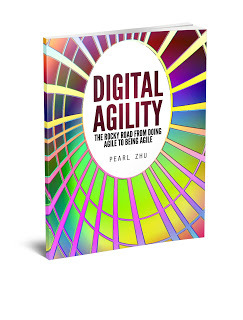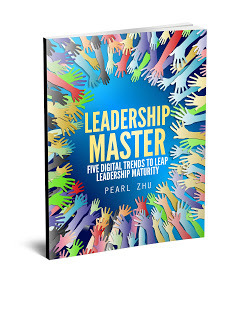Pearl Zhu's Blog, page 1326
June 21, 2016
The Book “Leadership Master” Quote Collection
 26 Amplifying digital leadership is not about how loud you can speak, but how profound you can think.
26 Amplifying digital leadership is not about how loud you can speak, but how profound you can think.
27 Leadership not profound is just like a tree without root.
28 What has to be enduring, and what will help the leader endure, would be authenticity.
29 The substance of leadership never changes, it’s all about making a positive influence, and providing direction.
30 A fundamental purpose of leadership is to provide vision and empower change.
31 The more gaps a leader can mind, the better and bigger influence she or he can make.
32 The hard core of leadership capabilities strengthens leadership effectiveness and highlights leadership substance.
33 Fundamentally leadership is about change and influencing people to change.
34 Empathy means using the right language with the right people
 35 The great leaders operate with the core principles: Authenticity, boldness, creativity, simplicity, and speed.
35 The great leaders operate with the core principles: Authenticity, boldness, creativity, simplicity, and speed.
36 The very goals of creating constructive discomfort is to spark creativity by getting out of comfort zone.
37 Culture is like a “tide,” leaders are swimming with or against much of it.
38 A wise leader does not just follow, but discover the path; not just learn, but challenge the convention.
39 If you only had one word to describe leadership, what would it be? “ART.”Follow us at: @Pearl_Zhu
Published on June 21, 2016 23:35
The Book “Digital Agility - The Rocky Road from Doing Agile to Being Agile” Conclusion
 Agile is both a philosophy and methodology to run a digital organization. Agility plays a significant impact on digital transformation. Agility involves the whole ecosystem, including all the stakeholders, from the customer’s requirement to the delivery, and common understanding is an essential input towards the transformation.
Agile is both a philosophy and methodology to run a digital organization. Agility plays a significant impact on digital transformation. Agility involves the whole ecosystem, including all the stakeholders, from the customer’s requirement to the delivery, and common understanding is an essential input towards the transformation.
Agile is a CULTURE, not a process: Agile is not SCRUM, it’s not xp, it’s a culture within which those processes can flourish. There can be an end state to learning a specific process, but self-improvement is a significant part of the underlying culture. If you want to transform the organization to radical digital, you need to change the mindset and culture. Many organizations are struggling with “being agile,” because they have no common understanding across the board, regardless of methodology, due to their overall culture or mindset. The mindset change has to do with understanding that doing things differently will bring about the business goal more effectively.
The organization becomes more resilient with high-level of digital agility: The world keeps on turning, spinning, and innovating around you, and there will be new technologies, new approaches, new tools, new people that will have an impact on your team and your organization. A agile business at any scale that can retain an overall sense of vision and purpose, can communicate effectively, continuously improve, reflect on its own limitations and respond to change dynamically. Eventually, you are spending time “trimming and paring,” finding small things to improve and adjusting to current conditions, looking for new ways to keep agile as a dynamic equilibrium rather than an “end state.”
 Agile is more as a direction, not a destination: Agile never ends: The driver for transformation would differ from organization to organization based on what the specific problem they are trying to solve is. It is that desired state to be that determines what the mode of the ecosystem of delivery would be. Nevertheless, eliminating waste and continuously improving should always be ongoing objectives even if you obtain sufficient agility since this can be lost as there are so many variables in the business environment. The more you improve in one area, the more could could expose weakness in others. So the hard part is not getting content with where you are, and always looking to continue improving.
Agile is more as a direction, not a destination: Agile never ends: The driver for transformation would differ from organization to organization based on what the specific problem they are trying to solve is. It is that desired state to be that determines what the mode of the ecosystem of delivery would be. Nevertheless, eliminating waste and continuously improving should always be ongoing objectives even if you obtain sufficient agility since this can be lost as there are so many variables in the business environment. The more you improve in one area, the more could could expose weakness in others. So the hard part is not getting content with where you are, and always looking to continue improving.The world is changing and continuous adaptation is the only way to survive in a competitive world. Agiel is no just a business principle, but a life principle. It’s a journey of learning, experimenting and improving.Follow us at: @Pearl_Zhu
Published on June 21, 2016 23:31
June 20, 2016
The Monthly Insight of Organizational Maturity June 2016
 Change is inevitable, organizational change has become a common practice within an organization, but too often changes are made as a reaction to outer impulses, crisis, and demands. This is the bureaucracy’s way of meeting the challenges. How to understand the mentalities behind the change as the first step, in order to fine tune the process of Change Management, and overcome the obstacles to managing a digital transformation smoothly?
Change is inevitable, organizational change has become a common practice within an organization, but too often changes are made as a reaction to outer impulses, crisis, and demands. This is the bureaucracy’s way of meeting the challenges. How to understand the mentalities behind the change as the first step, in order to fine tune the process of Change Management, and overcome the obstacles to managing a digital transformation smoothly?
Digital Organizational MaturityThe “Digital Way” of an Organizational Structure and Beyond: Organizations large or small are on the journey to digital transformation, and there are different theories of organizational structure evolution and continuous brainstorming about the concept of self-management, the format of future of the organization - from Holacracy to sociocracy; from agile to Stoos, etc. The whole point is how to build a more creative and productive working environment in which the employees’ talent can be unleashed; and business as a whole is more optimal than the sum of pieces, in order to adapt to the change with the accelerating speed? Ultimately, what's the digital way to run a business?
A Hybrid Organization With the fast pace of change and emerging digital technologies such as social, mobile and cloud, companies large or small are brainstorming the next generation of organizational design, how to take advantage of the new digital tools, how to improve productivity and enforce creativity & collaboration cross-enterprise ecosystem.
Three Digital Effects to Catalyze Business Maturity Digital transformation represents the next stage of business maturity which will improve how the enterprise works and interact with its ecosystem, with the customer at the center of its focus. Digital becomes the very fabric of the modern business, being outside-in and customer-centric is the new mantra for forward-looking digital organizations today. So how can businesses amplify positive digital effects and grow into the high-performing Digital Master?
How to Build a High-Performance Digital Organization: Due to the fierce competition and unprecedented uncertainty, the pressures from stakeholders, and “keep the light on” mentality, many organizations only focus on short-term profitability, with ignorance of forward-thinking and long-term vision, the life cycle of Fortune 500 companies have significantly shortened. Only very few forward-looking organizations have a long-term vision, transformational leadership, and well-tuned processes and capabilities to become a high mature Digital Master in pursuit of “Built to Last!” What are the characteristics of a forward-looking digital organization, and how to overcome the challenges to building a successful business for a long run?
 A Bimodal Digital Organization? Organizations large or small are on the journey to digital transformation, the paradox is that you need to keep the light on to maintain the stability, but also be adaptive to the changes caused by digital disruption with increasing speed. Hence, many businesses just have to run the bi-modal mode: the industrial speed to do what they always do, and the digital speed by leveraging innovation to experiment the new way to do things. But philosophically and methodologically, what’s the right balance between being quick to adopt new methods and risking them failing, and sticking with tried and tested ones and risking them becoming obsolete? Or more broadly speaking, how to strike the right balance between agility and stability?Blogging is not about writing, but about thinking; it’s not just about WHAT to say, but about WHY to say, and HOW to say it. It reflects the color and shade of your thought patterns, and it indicates the peaks and curves of your thinking waves. Unlike pure entertainment, quality and professional content takes time for digesting, contemplation and engaging, and therefore, it takes the time to attract the "hungry minds" and the "deep souls." It’s the journey to amplify your voice, deepen your digital footprints, and match your way for human progression.Follow us at: @Pearl_Zhu
A Bimodal Digital Organization? Organizations large or small are on the journey to digital transformation, the paradox is that you need to keep the light on to maintain the stability, but also be adaptive to the changes caused by digital disruption with increasing speed. Hence, many businesses just have to run the bi-modal mode: the industrial speed to do what they always do, and the digital speed by leveraging innovation to experiment the new way to do things. But philosophically and methodologically, what’s the right balance between being quick to adopt new methods and risking them failing, and sticking with tried and tested ones and risking them becoming obsolete? Or more broadly speaking, how to strike the right balance between agility and stability?Blogging is not about writing, but about thinking; it’s not just about WHAT to say, but about WHY to say, and HOW to say it. It reflects the color and shade of your thought patterns, and it indicates the peaks and curves of your thinking waves. Unlike pure entertainment, quality and professional content takes time for digesting, contemplation and engaging, and therefore, it takes the time to attract the "hungry minds" and the "deep souls." It’s the journey to amplify your voice, deepen your digital footprints, and match your way for human progression.Follow us at: @Pearl_Zhu
Published on June 20, 2016 22:42
“Leadership Master” Book Quote Collection II
 11. Fundamentally, leadership is more about future, but starts at today.
11. Fundamentally, leadership is more about future, but starts at today.
12 Leadership vision is built on the leader’s authenticity.
13. There are many multinational companies around, but very few global companies; there are many international managers, but very few true global leaders today.
14. Creative expansion cannot happen without vision.
15 To predict is to control, to co-create is to influence what you would like to bring into being.
16 A vision should be attainable subject to current times and its ability to adapt to changing times.
17 Generally speaking, vision is a future state of beings.
18 A wise leader doesn’t not just follow but discover the path.
19 The art of questioning is to ignite innovative thinking; the science of questioning is to frame system thinking, with the progressive pursuit of better solutions.
20 The answer from yesterday is not as critical as the questions about the future.
21 A set of excellent questions themselves is perhaps like a poem, both philosophical and intellectual.
 22 Change shouldn’t be treated as a singular occurrence when it is an ongoing, continued process and dynamic capability within the organization.
22 Change shouldn’t be treated as a singular occurrence when it is an ongoing, continued process and dynamic capability within the organization.
23 A strategy is a combination of an origin, a destination, and a route to get from origin to destination.
24 “Digital fit” should be first defined as “mind fi,” and then following with attitude fit and behavior fit.
25 The point is, framing the right problem is equally or even more important than solving it.
Follow us at: @Pearl_Zhu
Published on June 20, 2016 22:39
Book “Digital Agility” Introduction Chapter 8 Agile Debates
 Agile goes beyond a buzzword. It becomes a mainstream methodology to manage software, also emerges as a management philosophy to run today’s digital business. Agile originally started out as a revolution against rigid, dogmatic practices, the ironic is that the way some people practice Agile has come full circle back to that rigid adherence to the mechanics of how practices are implemented and have lost sight of the original intent of Agile. Agile spurs many fiery debates as well, such as Does Agile improve software quality or is it the very reason for defects increase? Is Agile the friend or the foe of creativity? Are Agile making managers happy, employees unhappy? Etc.
Agile goes beyond a buzzword. It becomes a mainstream methodology to manage software, also emerges as a management philosophy to run today’s digital business. Agile originally started out as a revolution against rigid, dogmatic practices, the ironic is that the way some people practice Agile has come full circle back to that rigid adherence to the mechanics of how practices are implemented and have lost sight of the original intent of Agile. Agile spurs many fiery debates as well, such as Does Agile improve software quality or is it the very reason for defects increase? Is Agile the friend or the foe of creativity? Are Agile making managers happy, employees unhappy? Etc.
Agile Paradox: Is “prescriptive” Agile practical? Based on its twelve agile principles, there are all sorts of agile explorement and deployment. Agile is a paradox because Agile is not lack of disciplines, but needs to be more disciplined than any other development methodology. “Prescriptive” Agile includes incremental recommendations to the team as they build experience. However, it doesn’t mean overly rigid processes or applies other’s best practices blindly. You can measure whether practices are being down and to what degree, but each team is different, hence, it isn’t really prescription, but more guidelines and heuristics. Regardless of which flavor of Agile practices you explore, you need to follow agile principles, people over process, change over documents, make continuous adjustments for your “prescriptive” agile formula, being agile rather than just doing Agile.
Is Agile the friend or foe of creativity? Agile is a fantastic way of working to involve everyone in the process of creation and delivery. Creativity is more of a culture thing rather being tied to a delivery process. Innovation and creativity are affected by the system at play in the organization. Agile projects that have great engagement and dialogue can be a fertile ground for creativity around how solutions are structured, designed and delivered. Agile stifles innovation when stakeholders dictate “how ” and not get “why” and “what.” Because when a team in Agile gets “how” in the format of a user story, they tend to look only in one direction, but when they get “what,” or “why,” they can think of the optimal solution. A motivated team will be creative and will innovation, but the team must have the latitude. The organization must allow for learning, experimentation, and failure. Therefore, organizational culture stifles creativity and innovation, not the frameworks used to deliver new products and services.
 Is management pulling in different directions when implementing Agile: Agile process is robust, more adapt to changes and people centric. Could it cause the other set of problems, and what are the “agile” distractions”? Could it decrease productivity because management pulling in different directions when implementing Agile? Agile welcomes dynamic tension. People pulling in different directions means that you are having different viewpoints considered. And if you could obtain a reasonable compromise, the solution will be good for all. People pull in different directions for reasons. If there is a conflict of interest, then there is no empirical approach that will make it go away. You need to get to the “what’s in it for me”” of the contenders. You need to work more on developing the unity of purpose. Ultimately, it is the top leadership team’s call to define what the business purpose is, and maybe take hard decisions. The Agile leaders have to listen to all demands and decide the path ahead, identifying and acknowledging the needs of all stakeholders and coming up with strategies that address everyone’s need.
Is management pulling in different directions when implementing Agile: Agile process is robust, more adapt to changes and people centric. Could it cause the other set of problems, and what are the “agile” distractions”? Could it decrease productivity because management pulling in different directions when implementing Agile? Agile welcomes dynamic tension. People pulling in different directions means that you are having different viewpoints considered. And if you could obtain a reasonable compromise, the solution will be good for all. People pull in different directions for reasons. If there is a conflict of interest, then there is no empirical approach that will make it go away. You need to get to the “what’s in it for me”” of the contenders. You need to work more on developing the unity of purpose. Ultimately, it is the top leadership team’s call to define what the business purpose is, and maybe take hard decisions. The Agile leaders have to listen to all demands and decide the path ahead, identifying and acknowledging the needs of all stakeholders and coming up with strategies that address everyone’s need. The healthy debates would help to clarify agile principles and philosophy, develop the tailored best and next agile practices, build a culture of creativity and inquisitiveness, and improve agile maturity Follow us at: @Pearl_Zhu
Published on June 20, 2016 22:36
June 19, 2016
“Leadership Master” Book Quote Collection I
 The defining qualities that will distinguish great leaders from the rest are stemmed from the mindset level.
The defining qualities that will distinguish great leaders from the rest are stemmed from the mindset level.
Authenticity is the most fundamental, but challenging attribute for leadership.
Paradoxes are conflicting choices or conditions that demand equal attentions.
Creative leadership can be described as “adaptability meets agility,” and “innovation meets principles.”
Innovative leadership is essentially anchored on the leader’s overall multifaceted resourcefulness and multidimensional competencies.
 It seems to be most of leaders have more conventional wisdom, but creative leaders have better common sense.
It seems to be most of leaders have more conventional wisdom, but creative leaders have better common sense.
The creativity strength is like a spinning wheel, you need to figure out how to boost it up.
Innovation is the change, change management needs to be an integral part of innovation management.
The search for the key to the “sustainable innovation holy grail” requires a specific understanding of innovator motivation.
Leadership view is multidimensional with the full spectrum of colors.Follow us at: @Pearl_Zhu
Published on June 19, 2016 23:42
“Digital Agility” Book Introduction Chapter 7 Agile Maturity
 Many organizations are transforming from doing Agile to being agile, apply agile philosophy, methodology, and practices to scaling up and building a truly agile organization is an important aspect of digital transformation. But what characteristics determine whether organizations are truly agile or just calling themselves agile? How do you define Agile maturity? And how to build a high-mature Agile organization?
Many organizations are transforming from doing Agile to being agile, apply agile philosophy, methodology, and practices to scaling up and building a truly agile organization is an important aspect of digital transformation. But what characteristics determine whether organizations are truly agile or just calling themselves agile? How do you define Agile maturity? And how to build a high-mature Agile organization?
Agility is a function of organizational culture, more than organizational practices: To quantify how much agile the organization is, involves analysis of their attitude and level of adoption about changes and innovation. An organization which can give up command and control to adapt a culture of learning and innovation via flatter structure and removing barriers of communication is on the right track to be an agile organization. That means, first organizations need to transform into collective agile mindset, build an agile culture which leads to agile behaviors and as much as you can measure behavior, then attempts to do so may provide you with some type of metrics that provide insight into the desired outcome when moving to agile. Agile success can improve the entire business competencies because they can do things quicker and better, encourage improvement and innovation.
The key strategic goal of an agile organization is also the key strategic goal of the organization to improve profitability: Agile not only a set of principles, but also a set of tactics which are in direct support of the core strategic goal of moving problem ownership to the front line and empowering the frontline to leal with their own problems. If that happened, your product and service quality would improve, the margins would rise, and you could reduce costs and successfully expand business and improve profitability. It means that in a highly agile organization, people take responsibility for their own work, for the product, and for the company as a whole. The goal of an agile organization is simply put to make a profit while respecting and promoting the integrity and well-being of its members and the community n which it resides and does business.
 Agilists are phenomenally disciplined in focusing on value, prioritizing, executing, and collaboration: Agile is too often misused and teams move too fast and they are faced with sacrificing reliable delivery, quality or technical excellence. It is critical to maintaining the core values. Agility means using what works and adapting to make it continue to improve, even it that means removing things that no longer work. What Agile did is to highlight the problem for all to see, so the upper management can rightly know it is their business decisions that got them here. After all, it is a business decision how you run your business issues outlined are all business problems which caused technical problems. Applying strategic agility practice is also about setting priority right to execute with adaptation. Therefore, a periodic assessment of overall strategic direction should not impede the use of agile, and deciding major moves the organization must make now to be ready for the challenges of the future.
Agilists are phenomenally disciplined in focusing on value, prioritizing, executing, and collaboration: Agile is too often misused and teams move too fast and they are faced with sacrificing reliable delivery, quality or technical excellence. It is critical to maintaining the core values. Agility means using what works and adapting to make it continue to improve, even it that means removing things that no longer work. What Agile did is to highlight the problem for all to see, so the upper management can rightly know it is their business decisions that got them here. After all, it is a business decision how you run your business issues outlined are all business problems which caused technical problems. Applying strategic agility practice is also about setting priority right to execute with adaptation. Therefore, a periodic assessment of overall strategic direction should not impede the use of agile, and deciding major moves the organization must make now to be ready for the challenges of the future. Being agile means anticipating likely change and addressing it deftly, keeping business on course and customer satisfied. To achieve those goals, agility must be built into an organization’s very foundation, design for emergence, innovation, to make change a nature evolution, and achieve high level business maturity..Follow us at: @Pearl_Zhu
Published on June 19, 2016 23:38
Running IT as an Innovation Hub
 IT is omnipresent and permeated into every corner of the organization. Forward-looking organizations are also reinventing IT reputation from a cost center to a value creator, from a static support function to a dynamic change agent; and from inside-out operation driven to outside-in customer-centric. To put simply, how can IT build differentiated capabilities to become an information power center and an innovation hub?
IT is omnipresent and permeated into every corner of the organization. Forward-looking organizations are also reinventing IT reputation from a cost center to a value creator, from a static support function to a dynamic change agent; and from inside-out operation driven to outside-in customer-centric. To put simply, how can IT build differentiated capabilities to become an information power center and an innovation hub?
Visionary IT leaders re-imagine IT as an innovation hub: Innovative IT can only happen if IT is regarded as a partner and given the role in catalyzing innovation and driving the business. However, the "us vs. them" mentality is often still alive in the management team within the organization. To ensure business as a whole is superior to the sum of pieces, the business leaders and managers have to overcome silo thinking and empower IT leaders to manage information across-functional border and unleash the full potential of digital business.With the changing role of IT in a world that is increasingly more people-centric from a technology perspective, it is imperative that the CIO be a visionary as well. The role of the CIO should be able to envision not only where a company believes it is going, but how it will get there, and how it might be missing out on opportunities because of limitations on understanding. More specifically, the understanding of what technology can help companies achieve. Everyone in the leadership team has a gift and the future business is very complex. Business models and technologies are changing very rapidly. There is no single person who is able to deal with these complexities and speed."Team Leadership" is able to build the future business and IT vision and, more importantly, to react very quickly.
Fostering innovation via leveraging disruptive technologies and enriched information flow: There are both incremental innovation and radical innovation. IT is often the driving force for both. IT plays a significant role in managing information-knowledge-insight cycle. Innovation is more about true knowledge acquisition first. Because if the organization has got that knowledge, it could accomplish a lot with less, and do more with innovation, and it could also use less than that 80% to achieve more than what it has today. IT needs also to ride above the learning curve, to fostering business innovation via leveraging disruptive technologies. Being able to become innovative or close is being able to think, and create new things based on its own needs, true knowledge is the optimal solution. To catalyze innovation, IT needs to ensure business strategy allowing for digital speed, If you can innovate across the business, regardless of which function you are involved in, be it IT, HR, Finance etc. then you can surely change the shape of what you deliver, not just how it's delivered.
 Balancing IT risks and opportunities: Nowadays we are living in an information explosive world where technology is pervasive and the masses are looking for their own experiences to introduce new technology into the business. At the age of IT consumerization, businesses need to understand not only the power and the opportunity information could bring in, but also the potential risks they might get exposed to. IT has to strike the right balance between innovation and standardization. It is important for IT to standardize the applications and devices customers use to keep support cost down and manage risks effectively. It is more important to fine tune business processes and organizational culture to encourage innovation. It’s all about striking the right balance to be both innovative and effective.
Balancing IT risks and opportunities: Nowadays we are living in an information explosive world where technology is pervasive and the masses are looking for their own experiences to introduce new technology into the business. At the age of IT consumerization, businesses need to understand not only the power and the opportunity information could bring in, but also the potential risks they might get exposed to. IT has to strike the right balance between innovation and standardization. It is important for IT to standardize the applications and devices customers use to keep support cost down and manage risks effectively. It is more important to fine tune business processes and organizational culture to encourage innovation. It’s all about striking the right balance to be both innovative and effective.
There is no one size fits all formula to run a high effective and high innovative IT. Because, different IT organizations and enterprise as a whole are at the different stage of business maturity. Running IT as an innovation hub means IT can be used as a tool, enabler, catalyzer, and a digital platform to orchestrate change and facilitate idea creation and implementation, meet the ultimate goal of an organization's short/medium/long-term strategic plans. The CIO is both an artist and a technologist - in brilliantly imagining the IT vision and business models of tomorrow while architecting the ability to succeed in the missions and business models of today.
Follow us at: @Pearl_Zhu
Published on June 19, 2016 23:36
June 18, 2016
“Leadership Master” Book Introduction Chapter 5 Profound Leadership
 At siloed industrial era, leadership effectiveness is perhaps dependent on the hierarchical level of authority and brute force style of command and control. However, now we live in a hyperconnected and over-complex digital ecosystem, digital flow changes the landscape of communication, collaboration and connection, command and control leadership style is no longer effective enough to make the influence and lead change smoothly. Because amplifying digital leadership is not about how loud you can speak, but how profound you could think. Digital leadership must go deeper, to touch the heart and mind, to practice the power of pull, to lead via influence, and to harmonize via positive thinking. In this chapter, we describe 13+ different leadership strengths to deepen leadership influence and enforce leadership effectiveness.
At siloed industrial era, leadership effectiveness is perhaps dependent on the hierarchical level of authority and brute force style of command and control. However, now we live in a hyperconnected and over-complex digital ecosystem, digital flow changes the landscape of communication, collaboration and connection, command and control leadership style is no longer effective enough to make the influence and lead change smoothly. Because amplifying digital leadership is not about how loud you can speak, but how profound you could think. Digital leadership must go deeper, to touch the heart and mind, to practice the power of pull, to lead via influence, and to harmonize via positive thinking. In this chapter, we describe 13+ different leadership strengths to deepen leadership influence and enforce leadership effectiveness.
Self-leadership: To know oneself is necessary to understand the filters and the bias. Self-reflection makes you more emphatic as a leader: Which quality makes you a strong leader? The advanced mindset or the exemplary behavior? The in-depth knowledge or profound wisdom? A leader’s individual journey is over the long haul and the goal should be to continually improve. From a strategic perspective, it’s also about planning, leadership at present is the missing link in business planning. Change, growth, self-leadership is the result and the ability to challenge oneself beyond the constraints of tradition. Self-leadership based on self-reflection and self-evaluation empowers us to be the change we want to see and lead change more effectively.
Gap-minding leadership: Leadership is about bridging today and future. There are all sorts of gaps need to be closed: Cognition gaps: In order to build a high-effective leadership team, foresightful organizations should always look for the complementary mindsets, capabilities, and skills that they don’t have so that they can build a winning team and complement each other. Generation Gaps: There is a surging need which is related to the realization that the gap is widening between the previously generation and the next generation, etc. The key to organizational success is to integrate next generation of leaders, tap into their way of looking at the world, solving problems with very collaborative working styles. Talent gap: Organizations not only need good managers to take care of today’s business but also have to grow the future leaders to leapfrog their companies for long-term prosperity.
 Change leadership: The world has changed significantly, and the speed of change is accelerating. Fundamentally leadership si about change and influencing people to change. There are differences between change management and change leadership. Change management which is the term refers to a set of basic tools or structures intended to keep any change effort under control, Change Leadership, on the other hand, concerns the driving forces, visions, and processes that fuel large-scale transformation. Leadership is about change management and also the ability to take initiative via change leadership.
Change leadership: The world has changed significantly, and the speed of change is accelerating. Fundamentally leadership si about change and influencing people to change. There are differences between change management and change leadership. Change management which is the term refers to a set of basic tools or structures intended to keep any change effort under control, Change Leadership, on the other hand, concerns the driving forces, visions, and processes that fuel large-scale transformation. Leadership is about change management and also the ability to take initiative via change leadership. Leadership is the ability to influence with or without authority. While there are many components of leadership, one of the most important ones is the ability to adapt, model and influence changes. Leadership becomes more open and omnipresent in the digital era because the hierarchy of an organization is flatter due to the latest digital disruption, the world has become more connected and transparent, effective leadership is based on its profundity, consistency, and the context of influence. Follow us at: @Pearl_Zhu
Published on June 18, 2016 23:45
“Digital Agility” Book Introduction Chapter 6: Agility Measurement
Being careful in establishing KPIs, as the old saying goes, you get what you measure.
 Business agility is the ability to sense, respond, and take actions to changes. It is a strategic imperative for companies’ surviving and thriving. But if you can only manage what you measure, how to measure business agility in order to continue building and improving business change capability and maturity?
Business agility is the ability to sense, respond, and take actions to changes. It is a strategic imperative for companies’ surviving and thriving. But if you can only manage what you measure, how to measure business agility in order to continue building and improving business change capability and maturity?
Agile values and principles are best measured via linking what you want to achieve: In agile, measure directly what you want to achieve, what your organizational goals are like such as go to the market time, cycle time to develop a feature, and anything that you truly want to see results from. Agile effectiveness is creating value, timely delivery, teamwork and productivity for the work done. If you want to measure agility, you need to be able to measure how well your organizations can respond. To be “agile,” you need to be able to respond effectively to change, From an agile perspective, the direction is more crucial than an absolute destination. You can measure the time from what a radical new requirement appears until the software is delivered, start with,” Doing the right thing,” before “doing things right.” And agility measurement needs to focus on:
-Timely delivery achieved frequently and repeatedly.
-Response to change quickly.
-Less cost to customers to support requirement changes.
Being careful in establishing KPIs, as the old saying goes, you get what you measure: Be sure to understand what decisions you are looking to make based on these KPIs. Since there will be an effort to collect and massage the raw data, you want to be sure that there are decisions made and actions taken based on the information provided. The measures should both motivate individuals as well as team performance. In the agile world, the team is more important than an individual, does focus on team KPI as well. From project/program management perspective, the goal is to deliver best, fast, good quality and cost-effective products or services and make the adjustment from spending organizational resources on something with low business value and slow ROI to deliver an alternative with much higher business value and faster ROI.
The “C” level executive may like to know something about ROI at macro level upon building the right products and culture: Each organization is different, and even within the same organization, and even if they do better by “being Agile,” there is no way to remove the confounding factors. But this will not stop an organization from measuring components of things that are measurable and will lead to favorable outcomes. Hence, at the macro level, Agile should be about how to ensure building the right product and portfolio on value, on time and on budget, focus on Agile mindset and culture, business and IT integration, portfolio management, the level of innovation. One of the most meaningful measures of Agile success is customer satisfaction. And the agile maturity measurement needs to say something about being truly agile, not just a lot of saying about doing agile activity, there is the right mix of strategic metrics and tactical metrics needed in measuring things really matter.
What gets measured, gets managed. Metrics is not the end-all solution to management, but simply another set of tools, data, and information sets. Businesses need to avoid vanity metrics and really focus on key metrics that correlate to better business outcomes. Follow us at: @Pearl_Zhu
 Business agility is the ability to sense, respond, and take actions to changes. It is a strategic imperative for companies’ surviving and thriving. But if you can only manage what you measure, how to measure business agility in order to continue building and improving business change capability and maturity?
Business agility is the ability to sense, respond, and take actions to changes. It is a strategic imperative for companies’ surviving and thriving. But if you can only manage what you measure, how to measure business agility in order to continue building and improving business change capability and maturity?
Agile values and principles are best measured via linking what you want to achieve: In agile, measure directly what you want to achieve, what your organizational goals are like such as go to the market time, cycle time to develop a feature, and anything that you truly want to see results from. Agile effectiveness is creating value, timely delivery, teamwork and productivity for the work done. If you want to measure agility, you need to be able to measure how well your organizations can respond. To be “agile,” you need to be able to respond effectively to change, From an agile perspective, the direction is more crucial than an absolute destination. You can measure the time from what a radical new requirement appears until the software is delivered, start with,” Doing the right thing,” before “doing things right.” And agility measurement needs to focus on:
-Timely delivery achieved frequently and repeatedly.
-Response to change quickly.
-Less cost to customers to support requirement changes.
Being careful in establishing KPIs, as the old saying goes, you get what you measure: Be sure to understand what decisions you are looking to make based on these KPIs. Since there will be an effort to collect and massage the raw data, you want to be sure that there are decisions made and actions taken based on the information provided. The measures should both motivate individuals as well as team performance. In the agile world, the team is more important than an individual, does focus on team KPI as well. From project/program management perspective, the goal is to deliver best, fast, good quality and cost-effective products or services and make the adjustment from spending organizational resources on something with low business value and slow ROI to deliver an alternative with much higher business value and faster ROI.
The “C” level executive may like to know something about ROI at macro level upon building the right products and culture: Each organization is different, and even within the same organization, and even if they do better by “being Agile,” there is no way to remove the confounding factors. But this will not stop an organization from measuring components of things that are measurable and will lead to favorable outcomes. Hence, at the macro level, Agile should be about how to ensure building the right product and portfolio on value, on time and on budget, focus on Agile mindset and culture, business and IT integration, portfolio management, the level of innovation. One of the most meaningful measures of Agile success is customer satisfaction. And the agile maturity measurement needs to say something about being truly agile, not just a lot of saying about doing agile activity, there is the right mix of strategic metrics and tactical metrics needed in measuring things really matter.
What gets measured, gets managed. Metrics is not the end-all solution to management, but simply another set of tools, data, and information sets. Businesses need to avoid vanity metrics and really focus on key metrics that correlate to better business outcomes. Follow us at: @Pearl_Zhu
Published on June 18, 2016 23:42



